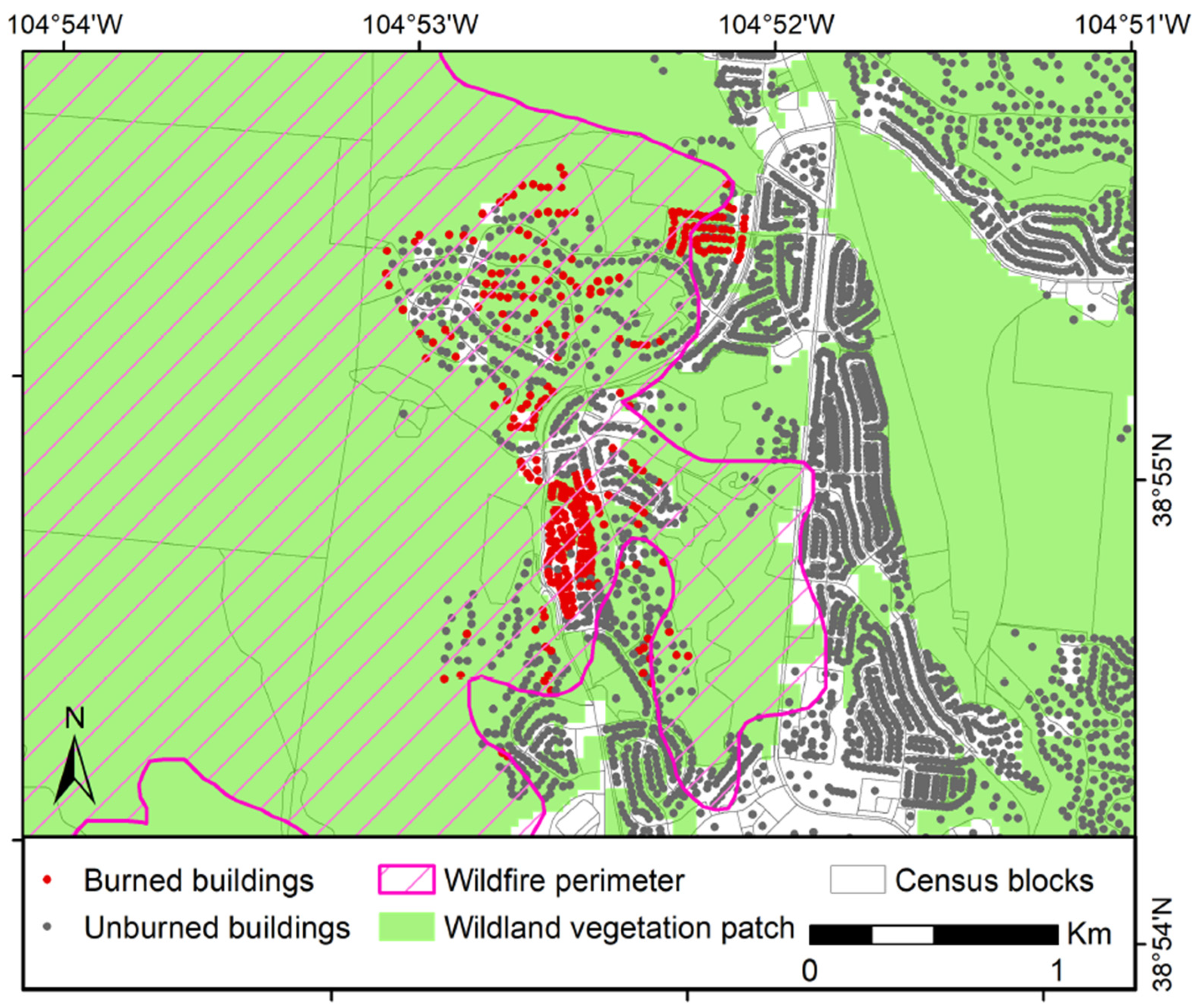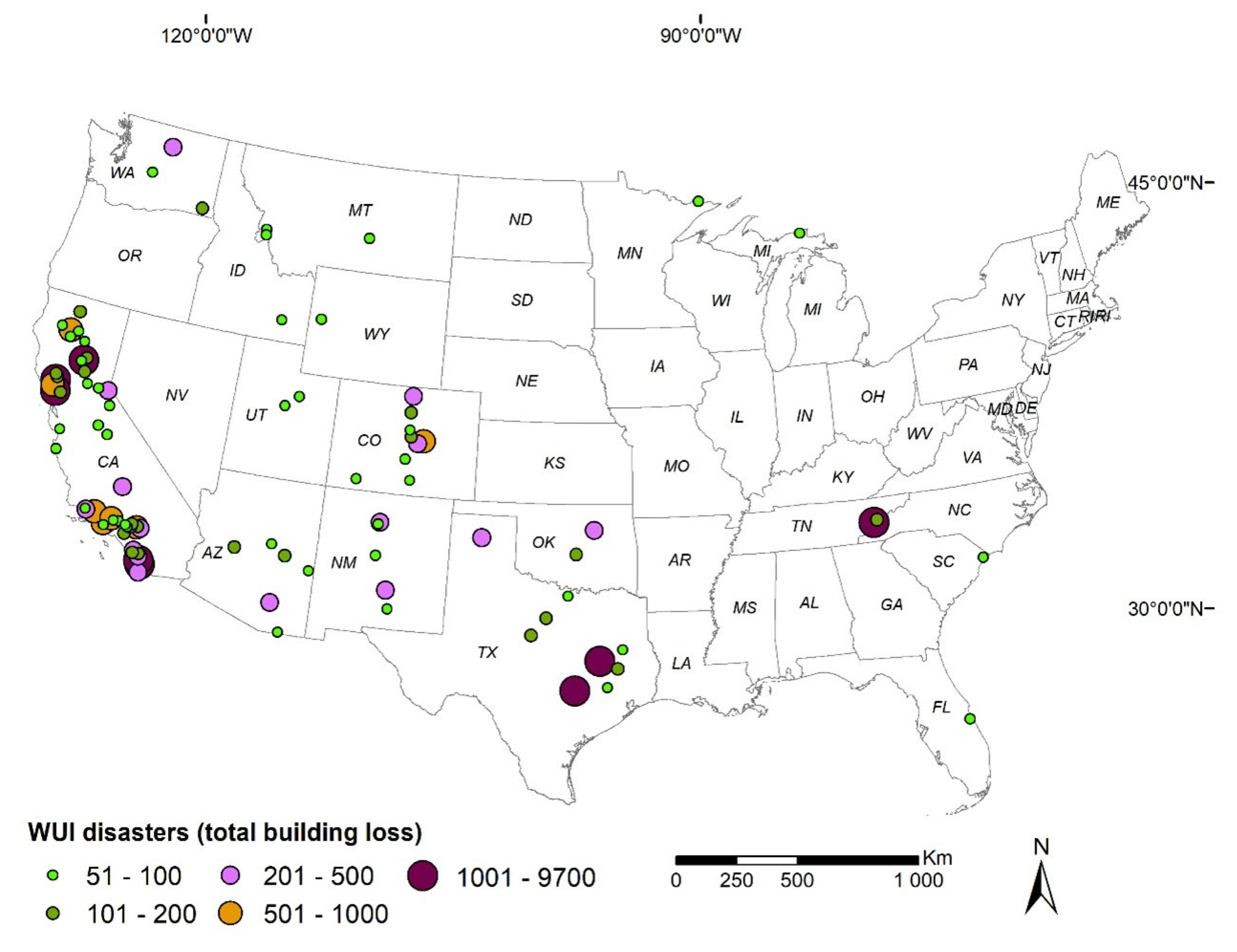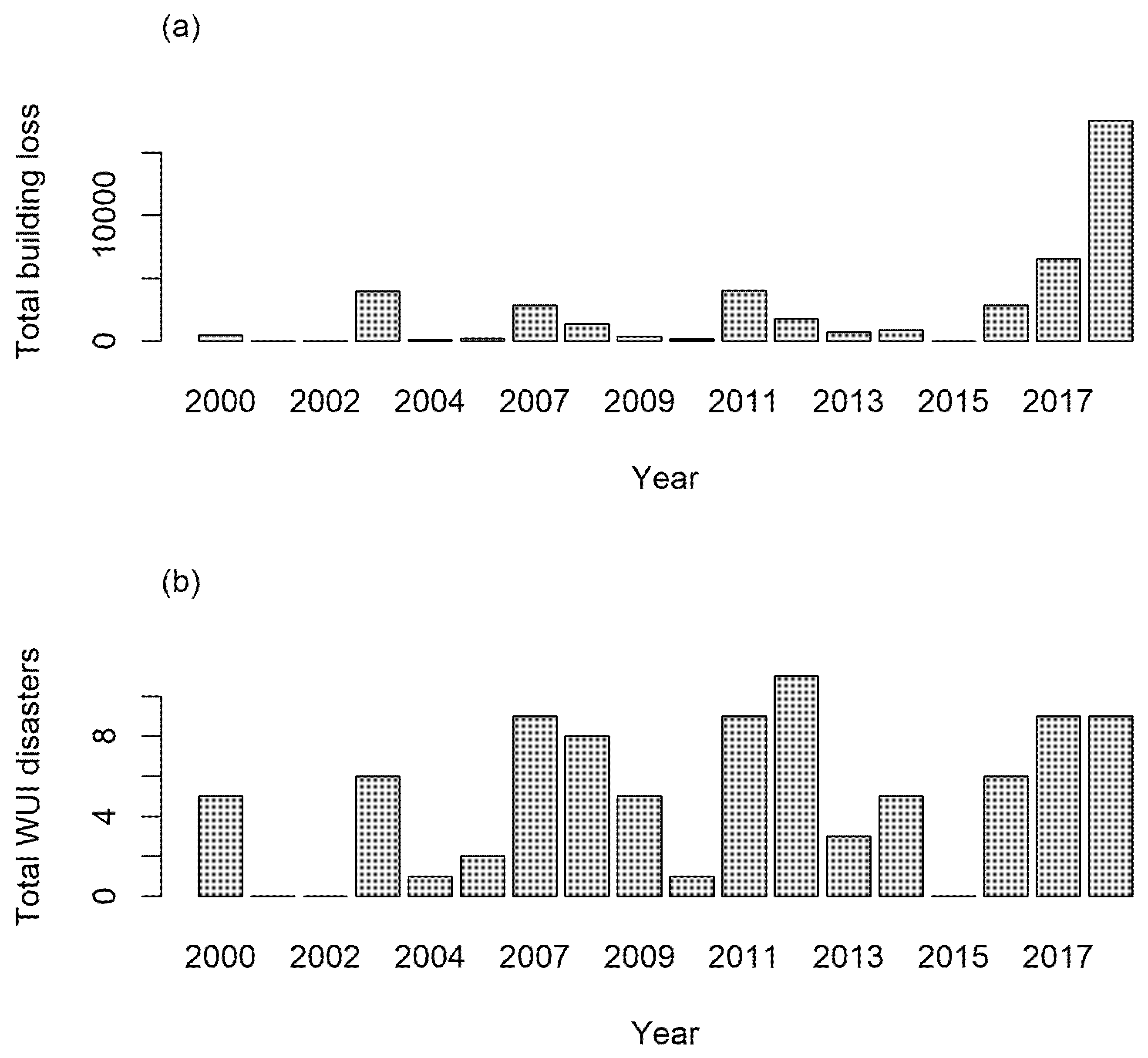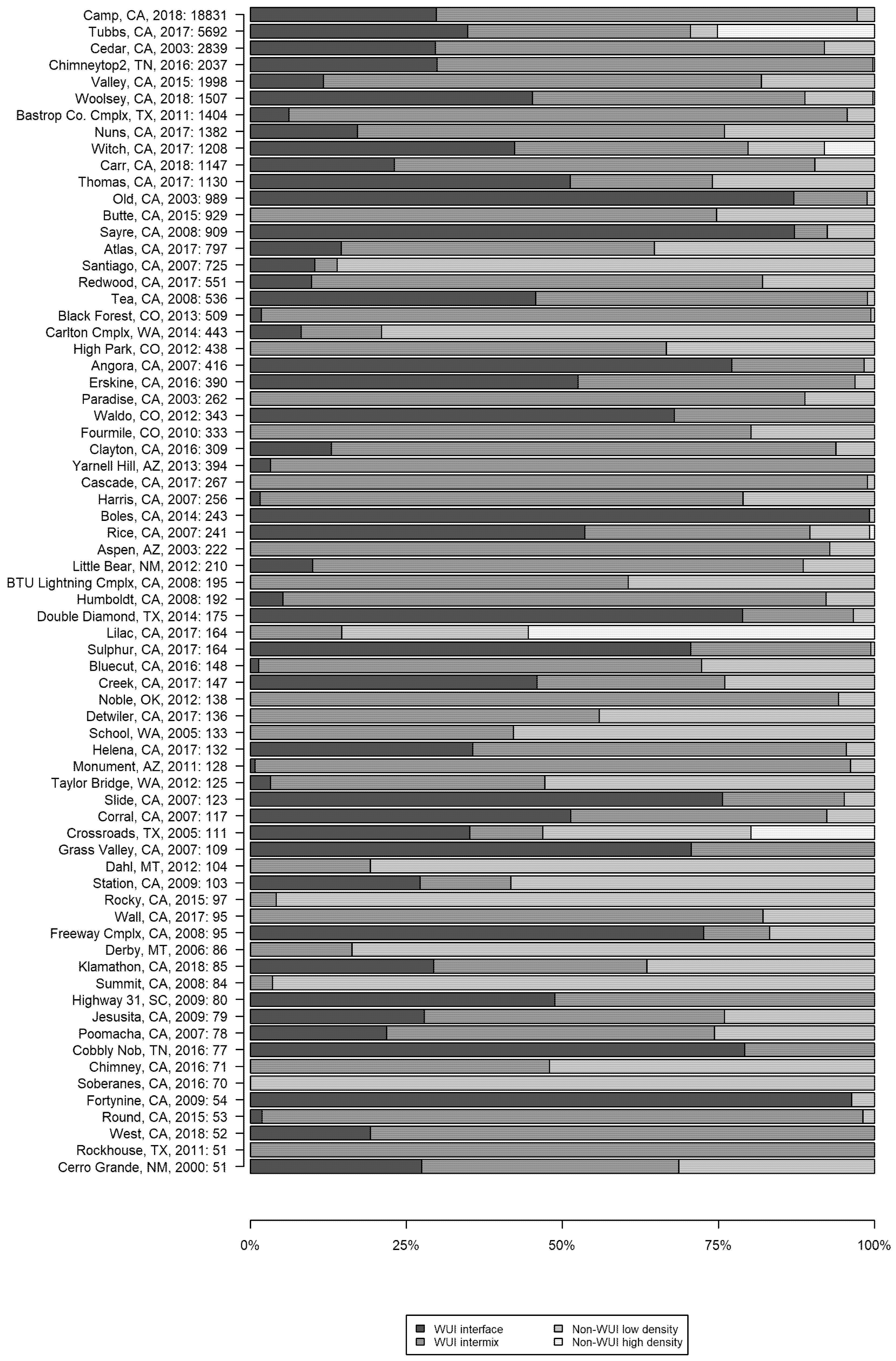Building Loss in WUI Disasters: Evaluating the Core Components of the Wildland–Urban Interface Definition
Abstract
1. Introduction
2. Methods and Data
2.1. Overview of Methods
2.2. Identifying WUI Disasters
2.3. Building Location Data
2.4. Census-Based WUI Map Building Loss
2.5. Point-Based WUI Map and Building Loss
3. Results
3.1. Identifying WUI Disasters
3.2. Census-Based WUI Map Building Loss
3.3. Determining the Scale to Measure WUI Components for Point-Based WUI Maps
3.4. Building Loss by Point-Based WUI Type
4. Discussion
Author Contributions
Funding
Conflicts of Interest
Disclaimers
References
- Theobald, D.M.; Romme, W.H. Expansion of the US wildland–urban interface. Landsc. Urban Plan. 2007, 83, 340–354. [Google Scholar] [CrossRef]
- Platt, R.V.; Schoennagel, T.; Veblen, T.T.; Sherriff, R.L. Modeling wildfire potential in residential parcels: A case study of the north-central Colorado Front Range. Landsc. Urban Plan. 2011, 102, 117–126. [Google Scholar] [CrossRef]
- Syphard, A.D.; Massada, A.B.; Butsic, V.; Keeley, J.E. Land use planning and wildfire: Development policies influence future probability of housing loss. PLoS ONE 2013, 8, e71708. [Google Scholar] [CrossRef] [PubMed]
- Haas, J.R.; Calkin, D.E.; Thompson, M.P. Wildfire risk transmission in the Colorado Front Range, USA. Risk Anal. 2015, 35, 226–240. [Google Scholar] [CrossRef]
- Radeloff, V.C.; Hammer, R.B.; Stewart, S.I.; Fried, J.S.; Holcomb, S.S.; McKeefry, J.F. The Wildland–Urban Interface in the United States. Ecol. Appl. 2005, 15, 799–805. [Google Scholar] [CrossRef]
- Gill, A.M.; Stephens, S.L. Scientific and social challenges for the management of fire-prone wildland–urban interfaces. Environ. Res. Lett. 2009, 4, 034014. [Google Scholar] [CrossRef]
- Syphard, A.D.; Keeley, J.E. Factors associated with structure loss in the 2013–2018 California wildfires. Fire 2019, 2, 49. [Google Scholar] [CrossRef]
- Corelogic. 2019 Wildfire Risk Report. Available online: https://www.corelogic.com/insights-download/wildfire-risk-report.aspx (accessed on 1 December 2020).
- Cohen, J.D. The wildland-urban interface fire problem: A consequence of the fire exclusion paradigm. For. Hist. Today 2008, Fall, 20–26. [Google Scholar]
- Calkin, D.E.; Cohen, J.D.; Finney, M.A.; Thompson, M.P. How risk management can prevent future wildfire disasters in the wildland-urban interface. Proc. Natl. Acad. Sci. USA 2014, 111, 746–751. [Google Scholar] [CrossRef]
- Balch, J.K.; Bradley, B.A.; Abatzoglou, J.T.; Nagy, R.C.; Fusco, E.J.; Mahood, A.L. Human-started wildfires expand the fire niche across the United States. Proc. Natl. Acad. Sci. USA 2017, 114, 2946–2951. [Google Scholar] [CrossRef]
- Hammer, R.B.; Stewart, S.I.; Radeloff, V.C. Demographic trends, the wildland–urban interface, and wildfire management. Soc. Nat. Resour. 2009, 22, 777–782. [Google Scholar] [CrossRef]
- Westerling, A.L.; Hidalgo, H.G.; Cayan, D.R.; Swetnam, T.W. Warming and earlier spring increase western U.S. forest wildfire activity. Science 2006, 313, 940–943. [Google Scholar] [CrossRef] [PubMed]
- Short, K.C. A spatial database of wildfires in the United States, 1992–2011. Earth Syst. Sci. Data 2014, 6, 1–27. [Google Scholar] [CrossRef]
- Smith, A.M.S.; Kolden, C.A.; Paveglio, T.B.; Cochrane, M.A.; Bowman, D.M.; Moritz, M.A.; Kliskey, A.D.; Alessa, L.; Hudak, A.T.; Hoffman, C.M.; et al. The science of firescapes: Achieving fire-resilient communities. BioScience 2016, 66, 130–146. [Google Scholar] [CrossRef]
- Paveglio, T.B.; Moseley, C.; Carroll, M.S.; Williams, D.R.; Davis, E.J.; Fischer, A.P. Categorizing the cocial context of the wildland urban interface: Adaptive capacity for wildfire and community “archetypes”. For. Sci. 2015, 61, 298–310. [Google Scholar] [CrossRef]
- Calkin, D.E.; Rieck, J.D.; Hyde, K.D.; Kaiden, J.D. Built structure identification in wildland fire decision support. Int. J. Wildland Fire 2011, 20, 78–90. [Google Scholar] [CrossRef]
- Bar-Massada, A.; Stewart, S.I.; Hammer, R.B.; Mockrin, M.H.; Radeloff, V.C. Using structure locations as a basis for mapping the wildland urban interface. J. Environ. Manag. 2013, 128, 540–547. [Google Scholar] [CrossRef]
- Jakes, P.; Burns, S.; Cheng, A.; Saeli, E.; Brummel, K.N.R.; Grayzeck, S.; Sturtevant, V.; Williams, D. Critical elements in the development and implementation of Community Wildfire Protection Plans (CWPPs). In The Fire Environment—Innovations, Management, and Policy, Proceedings of the RMRS-P-46CD, Destin, FL, USA, 26–30 March 2007; CD-ROM; Butler, B.W., Cook, W.C., Eds.; U.S. Department of Agriculture, Forest Service, Rocky Mountain Research Station: Fort Collins, CO, USA, 2007; pp. 613–624. [Google Scholar]
- Scott, J.H.; Thompson, M.P.; Calkin, D.E. A wildfire risk assessment framework for land and resource management. In Gen. Tech. Rep. RMRS-GTR-315; U.S. Department of Agriculture, Forest Service, Rocky Mountain Research Station: Station, 2013; Volume 315, p. 83. [Google Scholar] [CrossRef]
- Federal Register. Urban Wildland Interface Communities within the Vicinity of Federal Lands That Are at High Risk from Wildfire. Available online: https://www.federalregister.gov/documents/2001/01/04/01-52/urban-wildland-interface-communities-within-the-vicinity-of-federal-lands-that-are-at-high-risk-from (accessed on 2 December 2020).
- Martinuzzi, S.; Stewart, S.I.; Helmers, D.P.; Mockrin, M.H.; Hammer, R.B.; Radeloff, V.C. The 2010 Wildland-Urban Interface of the Conterminous United States; U.S. Department of Agriculture, Forest Service, Northern Research Station: Newtown Square, PA, USA, 2015. [CrossRef]
- Radeloff, V.C.; Helmers, D.P.; Kramer, H.A.; Mockrin, M.H.; Alexandre, P.M.; Bar-Massada, A.; Butsic, V.; Hawbaker, T.J.; Martinuzzi, S.; Syphard, A.D.; et al. Rapid growth of the US wildland-urban interface raises wildfire risk. Proc. Natl. Acad. Sci. USA 2018, 115, 3314. [Google Scholar] [CrossRef]
- Stewart, S.I.; Radeloff, V.C.; Hammer, R.B.; Hawbaker, T.J. Defining the wildland–urban interface. J. For. 2007, 105, 201–207. [Google Scholar] [CrossRef]
- Federal Register. Wildland-Urban Interface Federal Risk Mitigation. Available online: https://www.federalregister.gov/documents/2016/05/20/2016-12155/wildland-urban-interface-federal-risk-mitigation (accessed on 2 December 2020).
- Blaschke, T. Object based image analysis for remote sensing. ISPRS J. Photogramm. Remote Sens. 2010, 65, 2–16. [Google Scholar] [CrossRef]
- Caggiano, M.D.; Tinkham, W.T.; Hoffman, C.; Cheng, A.S.; Hawbaker, T.J. High resolution mapping of development in the wildland-urban interface using object based image extraction. Heliyon 2016, 2, e00174. [Google Scholar] [CrossRef] [PubMed]
- Leyk, S.; Uhl, J.H. HISDAC-US, historical settlement data compilation for the conterminous United States over 200 years. Sci. Data 2018, 5, 180175. [Google Scholar] [CrossRef] [PubMed]
- Microsoft Building Footprints-Bing Maps. Available online: https://www.microsoft.com/en-us/maps/building-footprints (accessed on 2 December 2020).
- Scott, J.H.; Thompson, M.P.; Gilbertson-Day, J.W. Exploring how alternative mapping approaches influence fireshed assessment and human community exposure to wildfire. GeoJournal 2017, 82, 201–215. [Google Scholar] [CrossRef]
- Stewart, S.I.; Wilmer, B.; Hammer, R.; Aplet, G.; Hawbaker, T.; Miller, C.; Radeloff, V. Wildland-urban interface maps vary with purpose and context. J. For. 2009, 107, 78–83. [Google Scholar]
- National Wildfire Coordinating Group. Wildfire Incident Status Summary Reports (ICS-209). Available online: https://famit.nwcg.gov/applications/SIT209/NIMSICS209 (accessed on 2 December 2020).
- Yang, L.; Jin, S.; Danielson, P.; Homer, C.; Gass, L.; Bender, S.M.; Case, A.; Costello, C.; Dewitz, J.; Fry, J.; et al. A new generation of the United States National Land Cover Database: Requirements, research priorities, design, and implementation strategies. ISPRS J. Photogramm. Remote Sens. 2018, 146, 108–123. [Google Scholar] [CrossRef]
- Katuwal, H.; Dunn, C.J.; Calkin, D.E. Characterising resource use and potential inefficiencies during large-fire suppression in the western US. Int. J. Wildland Fire 2017, 26, 604–614. [Google Scholar] [CrossRef]
- Alexandre, P.M.; Stewart, S.I.; Keuler, N.S.; Clayton, M.K.; Mockrin, M.H.; Bar-Massada, A.; Syphard, A.D.; Radeloff, V.C. Factors related to building loss due to wildfires in the conterminous United States. Ecol. Appl. 2016, 26, 2323–2338. [Google Scholar] [CrossRef]
- California Department of Forestry and Fire Protection CAL FIRE Damage Inspection Program. Available online: https://www.fire.ca.gov/ (accessed on 2 December 2020).
- Lin, G.; Milan, A.; Shen, C.; Reid, I. RefineNet: Multi-path refinement networks for high-resolution semantic segmentation. In Proceedings of the 2017 IEEE Conference on Computer Vision and Pattern Recognition (CVPR), Honolulu, HI, USA, 21–26 July 2017; pp. 5168–5177. [Google Scholar]
- Eidenshink, J.; Schwind, B.; Brewer, K.; Zhu, Z.-L.; Quayle, B.; Howard, S. A project for monitoring trends in burn severity. Fire Ecol. 2007, 3, 3–21. [Google Scholar] [CrossRef]
- U.S. Geological Survey. GeoMAC Wildfire Application. Available online: https://www.geomac.gov/ (accessed on 2 December 2020).
- Environmental Systems Research Institute. ArcGIS Desktop: Release 10; Environmental Systems Research Institute: Redlands, CA, USA, 2011. [Google Scholar]
- Chen, K.; McAneney, J. Quantifying bushfire penetration into urban areas in Australia. Geophys. Res. Lett. 2004, 31. [Google Scholar] [CrossRef]
- Solow, A.R. Mapping by simple indicator kriging. Math. Geosci. 1986, 18, 335–352. [Google Scholar] [CrossRef]
- Curran, P.J. The semivariogram in remote sensing: An introduction. Remote Sens. Environ. 1988, 24, 493–507. [Google Scholar] [CrossRef]
- Fawcett, T. An introduction to ROC analysis. Pattern Recognit. Lett. 2006, 27, 861–874. [Google Scholar] [CrossRef]
- Mueller, S.E.; Thode, A.E.; Margolis, E.Q.; Yocom, L.L.; Young, J.D.; Iniguez, J.M. Climate relationships with increasing wildfire in the southwestern US from 1984 to 2015. For. Ecol. Manag. 2020, 460, 117861. [Google Scholar] [CrossRef]
- Headwaters Economics Wildfires Destroy Thousands of Structures Each Year. Available online: https://headwaterseconomics.org/natural-hazards/structures-destroyed-by-wildfire/ (accessed on 2 December 2020).
- Wickham, J.; Stehman, S.V.; Gass, L.; Dewitz, J.A.; Sorenson, D.G.; Granneman, B.J.; Poss, R.V.; Baer, L.A. Thematic accuracy assessment of the 2011 National Land Cover Database (NLCD). Remote Sens. Environ. 2017, 191, 328–341. [Google Scholar] [CrossRef]
- Syphard, A.D.; Keeley, J.E.; Massada, A.B.; Brennan, T.J.; Radeloff, V.C. Housing arrangement and location determine the likelihood of housing loss due to wildfire. PLoS ONE 2012, 7, e33954. [Google Scholar] [CrossRef]
- Kramer, H.A.; Mockrin, M.H.; Alexandre, P.M.; Stewart, S.I.; Radeloff, V.C. Where wildfires destroy buildings in the US relative to the wildland–urban interface and national fire outreach programs. Int. J. Wildland Fire 2018, 27, 329–341. [Google Scholar] [CrossRef]
- Kramer, H.A.; Mockrin, M.H.; Alexandre, P.M.; Radeloff, V.C. High wildfire damage in interface communities in California. Int. J. Wildland Fire 2019, 28, 641–650. [Google Scholar] [CrossRef]
- Clark, A.M.; Rashford, B.S.; McLeod, D.M.; Lieske, S.N.; Coupal, R.H.; Albeke, S.E. The impact of residential development pattern on wildland fire suppression expenditures. Land Econ. 2016, 92, 656–678. [Google Scholar] [CrossRef]
- Maranghides, A.; Mell, W. Framework for Addressing the National Wildland Urban Interface Fire Problem—Determining Fire and Ember Exposure Zones Using a WUI Hazard Scale; U.S. Department of Commerce, National Institute of Standards and Technology: Newtown Square, PA, USA, 2012; p. 25.
- Koo, E.; Pagni, P.J.; Weise, D.R.; Woycheese, J.P. Firebrands and spotting ignition in large-scale fires. Int. J. Wildland Fire 2010, 19, 818–843. [Google Scholar] [CrossRef]
- Ager, A.A.; Day, M.A.; Palaiologou, P.; Houtman, R.M.; Ringo, C.; Evers, C.R. Cross-boundary wildfire and community exposure: A framework and application in the western U.S. In Gen. Tech. Rep. RMRS-GTR-392; U.S. Department of Agriculture, Forest Service, Rocky Mountain Research Station: Fort Collins, CO, USA, 2019; Volume 392, p. 36. [Google Scholar]
- Evers, C.R.; Ager, A.A.; Nielsen-Pincus, M.; Palaiologou, P.; Bunzel, K. Archetypes of community wildfire exposure from national forests of the western US. Landsc. Urban Plan. 2019, 182, 55–66. [Google Scholar] [CrossRef]
- Miller, S.R.; Wuerzer, T.; Vos, J.; Lindquist, E.; Mowery, M.; Holfeltz, T.; Stephens, B.; Grad, A. Planning for Wildfire in the Wildland-Urban Interface: A Resource Guide for Idaho Communities; Social Science Research Network: Rochester, NY, USA, 2016. [Google Scholar]
- Schoennagel, T.; Nelson, C.R.; Theobald, D.M.; Carnwath, G.C.; Chapman, T.B. Implementation of National Fire Plan treatments near the wildland-urban interface in the western United States. Proc. Natl. Acad. Sci. USA 2009, 106, 10706–10711. [Google Scholar] [CrossRef] [PubMed]





| Buildings Lost per Wildfire | Number of Wildfires | Number of Buildings Lost | ||
|---|---|---|---|---|
| Total | % | Total | % | |
| >1000 | 9 | 0.3% | 31,321 | 53.4% |
| 401–1000 | 8 | 0.3% | 4849 | 8.3% |
| 101–400 | 46 | 1.7% | 9283 | 15.8% |
| 51–100 | 45 | 1.6% | 3053 | 5.2% |
| 21–50 | 103 | 3.7% | 3439 | 5.9% |
| 6–20 | 286 | 10.3% | 3024 | 5.2% |
| 1–5 | 2280 | 82.1% | 3736 | 6.4% |
| Total | 2777 | 100.0% | 58,705 | 100.0% |
| Buildings within Fire Perimeters | Buildings Outside Fire Perimeters (≤2400 m) | |||||
|---|---|---|---|---|---|---|
| Wildland–Urban Interface Category | Count | Percent of Grand Total | Burned | Percent of Total Burned | ||
| WUI | ||||||
| Interface | 44,913 | 33% | 16,009 | 30% | 553,847 | |
| Intermix | 68,170 | 50% | 30,441 | 56% | 225,205 | |
| WUI total | 113,083 | 83% | 46,450 | 86% | 779,052 | |
| Non-WUI | ||||||
| Vegetation and no housing | 4089 | 3% | 819 | 2% | 12,532 | |
| Vegetation and very-low housing density | 12,107 | 9% | 3880 | 7% | 39,009 | |
| No vegetation and low to very-low housing density | 2719 | 2% | 986 | 2% | 27,347 | |
| No vegetation and medium to high housing density | 3418 | 3% | 1651 | 3% | 129,490 | |
| Non-WUI total | 22,333 | 17% | 7336 | 14% | 208,378 | |
| Grand total | 135,416 | 100% | 53,786 | 100% | 987,430 | |
| Building Density | Vegetation Cover | Distance to Wildland Vegetation | ||||||
|---|---|---|---|---|---|---|---|---|
| Radius (m) | AUC | R (Pseudo) | Radius (m) | AUC | R (Pseudo) | Patch Size (km2) | AUC | R (Pseudo) |
| 100 | 0.583 | 0.017 | 100 | 0.550 | 0.006 | 0.20 | 0.475 | 0.001 |
| 200 | 0.591 | 0.023 | 200 | 0.542 | 0.005 | 0.40 | 0.475 | 0.001 |
| 300 | 0.597 | 0.027 | 300 | 0.538 | 0.004 | 1.25 | 0.475 | 0.001 |
| 400 | 0.600 | 0.029 | 400 | 0.536 | 0.004 | 2.50 | 0.475 | 0.001 |
| 500 | 0.602 | 0.031 | 500 | 0.534 | 0.004 | 5.00 | 0.475 | 0.001 |
| 600 | 0.603 | 0.033 | 600 | 0.533 | 0.004 | |||
| 700 | 0.603 | 0.034 | 700 | 0.533 | 0.003 | |||
| 800 | 0.604 | 0.035 | 800 | 0.532 | 0.003 | |||
| 900 | 0.604 | 0.036 | 900 | 0.531 | 0.003 | |||
| 1000 | 0.604 | 0.036 | 1000 | 0.529 | 0.003 | |||
| Buildings within Fire Perimeters | Buildings Outside Fire Perimeters (≤2400 m) | |||||
|---|---|---|---|---|---|---|
| Wildland–Urban Interface Category | Count | Percent of Grand Total | Burned | Percent of Total Burned | ||
| WUI | ||||||
| Interface | 32,727 | 24% | 10,815 | 20% | 514,241 | |
| Intermix | 97,909 | 72% | 41,492 | 77% | 393,682 | |
| WUI total | 130,636 | 96% | 52,307 | 97% | 907,923 | |
| Non-WUI | ||||||
| Vegetation and no housing | 0 | 0% | 0 | 0% | ||
| Vegetation and very-low housing density | 4534 | 3% | 1424 | 3% | 16,795 | |
| No vegetation and low to very-low housing density | 246 | <1% | 55 | 0% | 2769 | |
| No vegetation and medium to high housing density | 0 | 0% | 0 | 0% | 59,943 | |
| Non-WUI total | 4780 | 4% | 1479 | 3% | 79,507 | |
| Grand total | 135,416 | 100% | 53,786 | 100% | 987,430 | |
Publisher’s Note: MDPI stays neutral with regard to jurisdictional claims in published maps and institutional affiliations. |
© 2020 by the authors. Licensee MDPI, Basel, Switzerland. This article is an open access article distributed under the terms and conditions of the Creative Commons Attribution (CC BY) license (http://creativecommons.org/licenses/by/4.0/).
Share and Cite
Caggiano, M.D.; Hawbaker, T.J.; Gannon, B.M.; Hoffman, C.M. Building Loss in WUI Disasters: Evaluating the Core Components of the Wildland–Urban Interface Definition. Fire 2020, 3, 73. https://doi.org/10.3390/fire3040073
Caggiano MD, Hawbaker TJ, Gannon BM, Hoffman CM. Building Loss in WUI Disasters: Evaluating the Core Components of the Wildland–Urban Interface Definition. Fire. 2020; 3(4):73. https://doi.org/10.3390/fire3040073
Chicago/Turabian StyleCaggiano, Michael D., Todd J. Hawbaker, Benjamin M. Gannon, and Chad M. Hoffman. 2020. "Building Loss in WUI Disasters: Evaluating the Core Components of the Wildland–Urban Interface Definition" Fire 3, no. 4: 73. https://doi.org/10.3390/fire3040073
APA StyleCaggiano, M. D., Hawbaker, T. J., Gannon, B. M., & Hoffman, C. M. (2020). Building Loss in WUI Disasters: Evaluating the Core Components of the Wildland–Urban Interface Definition. Fire, 3(4), 73. https://doi.org/10.3390/fire3040073






